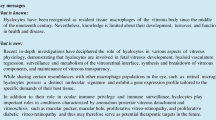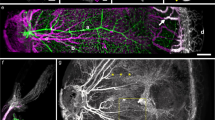Abstract
The embryonic development of the cell population of the mammalian vitreous has been traced to two sources: the undifferentiated mesenchymal cells of the eye primordium and the primitive reticular cells of the bone marrow. Undifferentiated mesenchymal cells invade the future vitreous space in two ways: through the annular opening between the rim of the optic cup and the lens primordium, and through the open embryonic fissure. They differentiate into prevascular cells, hemangioblasts, and fibrocytes located in the area of the optic nerve head. From the very beginning of fetal development, another ameboid-type cell of mesenchymal origin makes its entrance into the vitreous through the hyaloid vessels; these monocyte-like cells differentiate into hyalocytes and populate a well-defined area of the cortical vitreous close to the retina and to the ora serrata. Gamma-irradiation (600 rads) of newly born rabbits and cats decreases the number of migrating amebocytes in their vitreous; 24 h later, however, they are replaced by monocytes from the hyaloid vessels.
Zusammenfassung
In der Embryonalentwicklung der im Corpus vitreosus von Säugern nachweisbaren Zellpopulation lassen sich 2 Ursprünge dieser Glaskörperzellen nachweisen: die undifferenzierten Mesenchymzellen der Augenanlage und die primitiven Reticulumzellen des Knochenmarks.
Undifferenzierte Mesenchymzellen gelangen entweder durch die kreisförmige Öffnung zwischen dem Rand des Augenbechers und der Linsenanlage oder durch den offenen Augenbecherspalt in den späteren Glaskörperraum. In der Umgebung des Sehnerveneintritts differenzieren sie sich in angiogenetische Zellen, Haemangioblasten und Fibrocyten. Eine weitere amöboide Zellart gelangt in den Frühstadien der Fetalentwicklungen durch die Vasa hyaloidea in den Glaskörper. Diese monocytenartigen Zellen entwickeln sich zu Hyalocyten und besiedeln einen abgrenzten Bereich der Glaskörperrinde in unmittelbarer Nachbarschaft zur Retina und zur Ora serrata. Gamma-Bestrahlung (600 rad) neugeborener Kaninchen und Katzen verringert die Anzahl dieser Glaskörperrindenzellen; 24 Stunden später sind sie jedoch durch aus den Vasa hyaloidea eingewanderte Monocyten ersetzt.
Similar content being viewed by others
References
Agarwal, P.K., Agarwal, L.P., Tandon, H.D.: The cellular structure of the hyaloid system of the rat. Orient. A. Ophthal. 2, 279–282 (1964)
Balazs, E.A.: Fine structure of developing vitreous. In International Ophthalmology Clinics. Ocular fine structure for the clinician. (Ed. Zinn, K.) Vol 15, No. 1, pp 53–63. Boston: Little, Brown and Company 1975
Balazs, E.A., Bloom, G.D., and Ozanics, V.: The fine structure of the hyaloid arteriole in bovine vitreous. Exp. Eye Res. (in press)
Balazs, E.A., Laurent, T.C., Laurent, U.B.G.: Studies on the structure of the vitreous body. J. Biol. Che. 234, 422–430 (1959)
Balazs, E.A., Sundblad, L., Toth, L.Z.: In vitro formation of hyaluronic acid by cells of the vitreous body and by comb tissue. Fed. Proc. 17, 184 (1958)
Balazs, E.A., Toth, L.Z., Eckl, E.A., Mitchell, A.P.: Studies on the structure of the vitreous body. XII. Cytological and histochemical studies on the cortical tissue layer. Exp. Eye Res. 3, 57–71 (1964)
Balazs, E.A., Toth, L.Z., Jutheden, G.M., Collins, B.A.: Cytological and biochemical studies on the developing chicken vitreous. Exp. Eye Res. 4, 237–248 (1965)
Bertacchini, P.: Sviluppo e struttura del corpo vitreo i alcuni vertebrati. Int. Mechr. Anat. Physiol. 19, 77–118 (1902)
Bloom, G.D., and Balazs, E.A.: An electron microscopic study of hyalocytes. Exp. Eye Res. 4, 249–255 (1965)
Dejean, C.: Origine du collagène et développement du corps vitré et la zonule de Zinn dans l'oeil des vertèbres. Arch. Anat. Micros. Morph. Exp. 21, 3 (1925)
Freeman, M.I., Jacobson, B., Toth, L.Z., Balazs, E.A.: Lysosomal enzymes associated with vitreous hyalocyte granules. I. Intracellular distribution patterns of enzymes. Exp. Eye Res. 7, 113–120 (1968)
Gloor, B.P.: Zur Entwicklung des Glaskörpers und der Zonula. III. Herkunft, Lebenszeit und Ersatz der Glaskörperzellen beim Kaninchen (Autoradiographische Untersuchungen mit 3H-thymidin). Albrecht v. Graefes Arch. klin. exp. Ophthal. 187, 21–44 (1973a)
Gloor, B.P.: Zur Entwicklung des Glaskörpers und der Zonula. II. Glaskörperzellen während Entwicklung und Rückbildung der Vasa hyaloidea und der Tunica vasculosa lentis. Albrecht v. Graefes Arch. klin. exp. Ophthal. 186, 311–328 (1973b)
Gloor, B.P.: Zur Entwicklung des Glaskörpers und der Zonula. I. Überblick und chronologischer Ablauf der Glaskörper- und Zonulaentwicklung bei Kaninchen und Maus. Albrecht V. Graefes Arch. klin. exp. Ophthal. 186, 299–309 (1973c)
Gurr, E.: Methods of analytical histology and histochemistry. London: L. Hill Ltd. 1958
Hamburg, A.: Some investigations on the cells of the vitreous body. Ophthalmologica 138, 81–107 (1959)
Henle, J.: Allgemeine Anatomie Leipzig: L. Vos 1841
Hultsch, E., and Balazs, E.A.: In vitro synthesis of glycosaminoglycans and glycoproteins by cells of the vitreous body. Annual meeting of the Association for Research in Vision and Ophthalmology (ARVO), p. 43 (1973)
Hyvarinen, L.: Vascular structures of the rabbit retina. Acta Ophthal. 45, 852–861 (1967)
Jack, R.L.: Ultrastructural aspects of hyaloid vessel development. Arch. Ophthal. 87, 427–437 (1972a)
Jack, R.L.: Ultrastructure of the hyaloid vascular system. Arch. Ophthal. 87, 555–567 (1972b)
Jack, R.L.: Regression of the hyaloid vascular system. An ultrastructural analysis. Amer. J. Ophthal. 74, 261–272 (1972c)
Jacobson, B.: Biosynthesis of Hyaluronic acid in the vitreous. V. Studies on a particulate hyalocyte glycosyl transferase. Exp. Eye Res. 27, 247–258 (1978)
Jacobson, B.: Biosynthesis of hyaluronic acid in the vitreous. VI. Isolation of a complex containing hyaluronic acid and glycosyl transferase activity and studies on the activity of a soluble glycosyl transferase. Exp. Eye Res. 27, 259–273 (1978)
Jokl, A.: Vergleichende Untersuchungen über den Bau und Entwicklung des Glaskörpers und seinem Inhaltsgebilde bei Wirbeltieren und Menschen. Stockholm: Thesis Almquist, Wiksell 1927
Kessler, L.: Zur Entwicklung des Auges der Wirbeltiere. Leipzig: 1871
Kölliker, A.: Entwicklungsgeschichte des Menschen und der höheren Tiere. Leipzig: 1879
Lenhossek, M. von: Die Entwicklung des Glaskörpers. Leipzig: Vogel 1903
Lopashov, G.V., Stroeva, O.G.: Development of the Eye. Experimental Studies. New York: Davey & Co., Inc. 1964
Mann, I.C.: The Development of the Human Eye. New York: Grune and Stratton Inc. 1964
McManus, J.F.A., Mowry, R.W.: Staining Methods. New York: Hoeber, Inc. 1960
Mutlu, F., Leopold, J.H.: The structure of fetal hyaloid system and tunica vasculosa lentis. Arch. Ophthal. 71, 102–110 (1964)
Osterlin, S.E. and Jacobson, B.: The synthesis of hyaluronic acid in the vitreous I. Soluble and particulate transferases in hyalocytes. Exp. Eye Res. 7, 497–510 (1968)
Ranvier, L.: Des vaissaux et des clasmatocytes de l'hyaloide de la grenouille. Compt. Rend. 115, 1230–1233 (1892)
Szirmai, J.A., Balazs, E.A.: Studies on the structure of the vitreous body. III. Cells in the cortical layer. Arch. Ophthal. 59, 34–48 (1958)
Szily, A. von: Zur Glaskörperfrage, eine vorläufige Mitteilung. Anat. Anz. 24, 417 (1904)
Tornatola, S.: Origine et nature du corps vitré. Rev. génér, d'opht. 14 année Moscow (1897)
Toth, L.Z.: Origin and embryonic development of the vitreous body and the hyalocytes of the domestic chicken (Gallus domesticus). Invest. Ophthal. 3, 473 (1964)
Virchow, R.: Notiz über den Glaskörper. Arch. Pathol Anat. Physiol. 4, 468 (1852)
Weiss, L.P., Fawcett, D.W.: Cytochemical observations on chicken monocytes. macrophages and giant cells in tissue culture. J. Histochem. Cytochem. 1, 47–65 (1953)
Willmer, E.N.: Cytology and Evolution. New York: Academic Press 1960
Wolfrum, M.: Zur Entwicklung und normalen Struktur des Glaskörpers. Arch. Ophthal. 65, 220 (1907)
Wolter, J.R.: Pores in the internal limiting membrane of the human retina. Acta Ophthal. 42, 971–974 (1964)
Author information
Authors and Affiliations
Additional information
This investigation was supported by National Institutes of Health Research Grants No. EY 001747 and EY 00184 from the National Eye Institute
Rights and permissions
About this article
Cite this article
Balazs, E.A., Toth, L.Z. & Ozanics, V. Cytological studies on the developing vitreous as related to the hyaloid vessel system. Albrecht von Graefes Arch. Klin. Ophthalmol. 213, 71–85 (1980). https://doi.org/10.1007/BF00413534
Received:
Issue Date:
DOI: https://doi.org/10.1007/BF00413534




